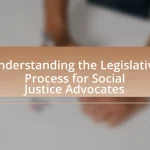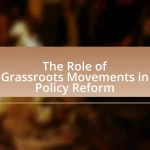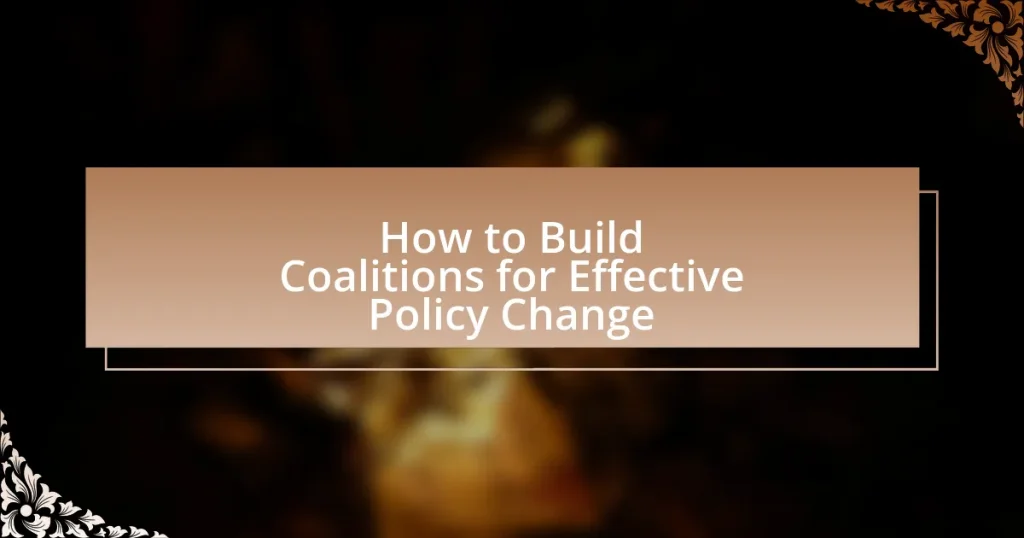Coalitions are formal alliances formed by diverse stakeholders to achieve common goals, particularly in influencing policy change. This article explores the significance of coalitions in advocacy, highlighting their ability to consolidate resources, enhance public support, and amplify the voices of marginalized groups. Key characteristics of effective coalitions, such as shared goals, strong leadership, and diversity, are examined, along with strategies for building and sustaining coalitions. Additionally, the article addresses challenges faced in coalition building and offers best practices for measuring effectiveness and adapting to changing political landscapes.
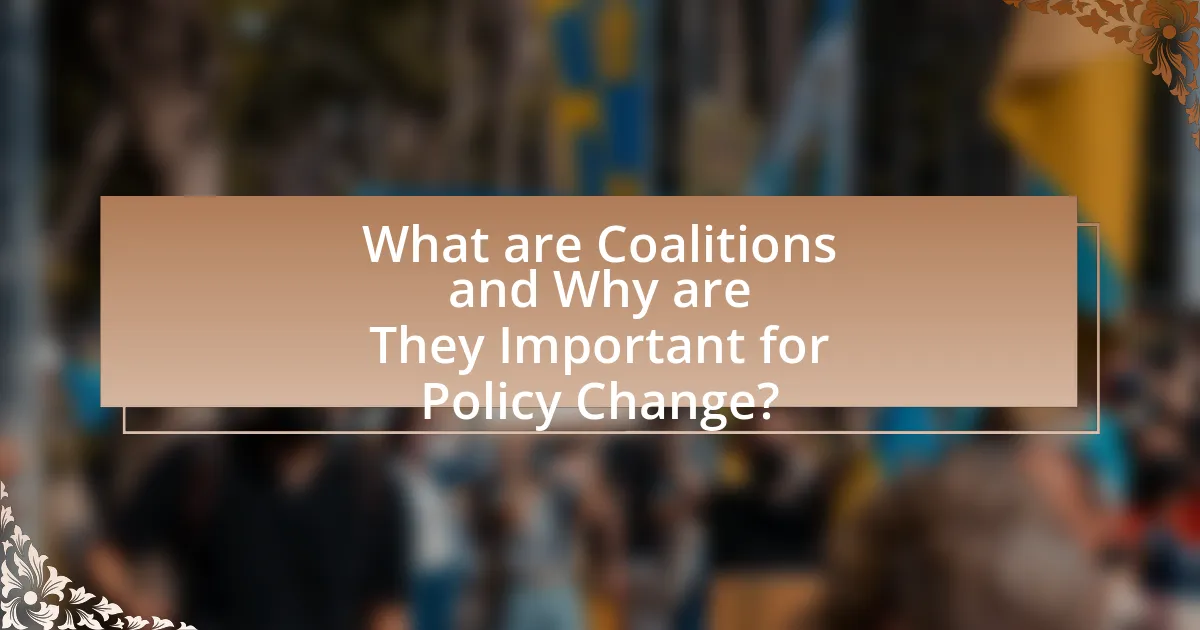
What are Coalitions and Why are They Important for Policy Change?
Coalitions are alliances formed by individuals or organizations that come together to achieve a common goal, particularly in the context of influencing policy change. They are important for policy change because they consolidate resources, expertise, and influence, thereby amplifying the voices of diverse stakeholders. Research shows that coalitions can increase the likelihood of successful advocacy efforts; for example, a study by the Center for American Progress found that coalitions can enhance the effectiveness of campaigns by pooling knowledge and mobilizing broader public support. This collaborative approach not only strengthens the argument for policy change but also fosters a sense of shared responsibility among participants, making it more likely that proposed changes will be implemented.
How do coalitions differ from other forms of collaboration?
Coalitions differ from other forms of collaboration primarily in their structure and purpose, as they are typically formed by multiple organizations or groups that unite for a specific goal, often related to policy change. Unlike informal collaborations or partnerships that may focus on shared interests or projects, coalitions are characterized by a formal agreement among diverse stakeholders to leverage their collective resources and influence to achieve a common objective, such as advocating for legislative reforms or addressing social issues. This structured approach allows coalitions to mobilize a broader base of support and create a more significant impact than individual organizations could achieve alone, as evidenced by successful coalitions like the Coalition for Healthier Cities and Communities, which effectively influenced public health policies through collective action.
What are the key characteristics of effective coalitions?
Effective coalitions are characterized by shared goals, strong leadership, diverse membership, effective communication, and mutual trust. Shared goals ensure that all members are aligned in their objectives, which fosters collaboration. Strong leadership provides direction and motivates members to engage actively. Diverse membership brings various perspectives and resources, enhancing problem-solving capabilities. Effective communication facilitates transparency and coordination among members, while mutual trust builds a solid foundation for collaboration, allowing for open dialogue and conflict resolution. These characteristics are essential for coalitions to successfully influence policy change and achieve their objectives.
Why is diversity important in coalition building?
Diversity is important in coalition building because it enhances the coalition’s ability to address complex social issues by incorporating a wide range of perspectives and experiences. This variety leads to more innovative solutions and better decision-making, as diverse groups are more likely to consider different viewpoints and challenge assumptions. Research indicates that diverse teams outperform homogeneous ones in problem-solving and creativity, as evidenced by a study published in the Harvard Business Review, which found that diverse teams are 35% more likely to outperform their peers. Therefore, diversity not only strengthens coalitions but also increases their effectiveness in achieving policy change.
What role do coalitions play in influencing policy?
Coalitions play a crucial role in influencing policy by uniting diverse stakeholders to amplify their collective voice and impact. By combining resources, expertise, and networks, coalitions enhance advocacy efforts, making it easier to sway policymakers and public opinion. For instance, the 2010 Affordable Care Act saw numerous coalitions, including healthcare providers and patient advocacy groups, successfully lobbying for reforms by presenting a unified front, which significantly increased their influence on legislative outcomes.
How can coalitions amplify the voices of marginalized groups?
Coalitions can amplify the voices of marginalized groups by uniting diverse stakeholders to advocate for shared goals and increase visibility. By pooling resources, knowledge, and networks, coalitions enhance the capacity of marginalized groups to influence policy and public opinion. For instance, the National Domestic Workers Alliance has successfully mobilized various organizations to advocate for labor rights, resulting in legislative changes that protect domestic workers, a historically marginalized group. This collective action not only raises awareness but also provides a platform for marginalized voices to be heard in decision-making processes.
What strategies do coalitions use to impact decision-makers?
Coalitions use strategies such as collective advocacy, data-driven campaigns, and grassroots mobilization to impact decision-makers. Collective advocacy allows diverse groups to present a unified message, increasing their influence. Data-driven campaigns leverage research and statistics to support policy proposals, making them more compelling to decision-makers. Grassroots mobilization engages community members to demonstrate public support, which can pressure policymakers to act. For instance, studies show that coalitions that effectively mobilize constituents can significantly sway legislative outcomes, as seen in the successful campaigns for healthcare reform in various states.
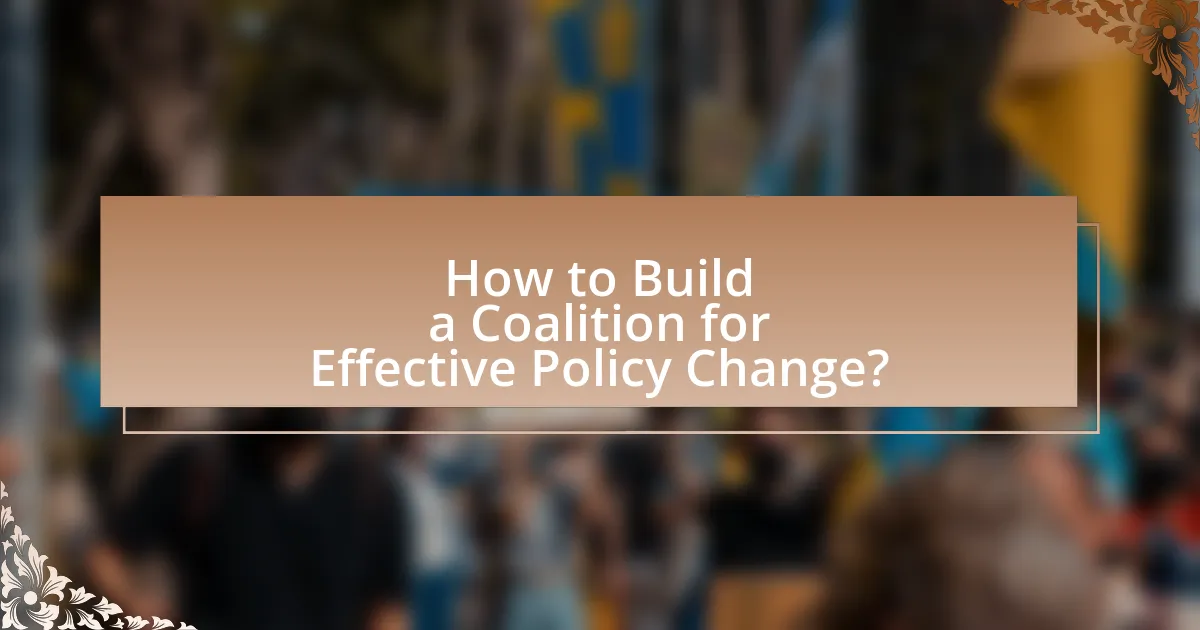
How to Build a Coalition for Effective Policy Change?
To build a coalition for effective policy change, identify and engage diverse stakeholders who share a common interest in the policy issue. This involves mapping out potential allies, including community organizations, advocacy groups, and relevant government entities, to ensure a broad representation of perspectives and resources. Research indicates that coalitions with varied membership are more successful in influencing policy outcomes, as they can leverage different strengths and networks (Butterfoss, 2007). Establishing clear goals, fostering open communication, and creating a shared vision among coalition members further enhances collaboration and effectiveness in driving policy change.
What are the initial steps in forming a coalition?
The initial steps in forming a coalition include identifying common goals, gathering stakeholders, and establishing a shared vision. First, stakeholders must recognize mutual interests or objectives that necessitate collaboration. Next, it is essential to engage diverse groups, including community members, organizations, and policymakers, to ensure broad representation and support. Finally, articulating a clear and compelling vision helps unify the coalition and guides its efforts toward achieving the identified goals. These steps are critical for laying a strong foundation for effective collaboration and policy change.
How do you identify potential coalition members?
To identify potential coalition members, assess shared goals and interests among organizations or individuals that align with the coalition’s objectives. This involves conducting stakeholder analysis to pinpoint entities that have a vested interest in the policy change, as well as evaluating their influence, resources, and willingness to collaborate. For instance, research indicates that successful coalitions often include diverse stakeholders such as non-profits, businesses, and community leaders who can contribute unique perspectives and resources, enhancing the coalition’s effectiveness in achieving policy goals.
What criteria should be used to select coalition partners?
The criteria for selecting coalition partners include shared goals, complementary resources, and mutual trust. Shared goals ensure that all partners are aligned in their objectives, which is crucial for effective collaboration. Complementary resources, such as expertise, funding, or networks, enhance the coalition’s capacity to achieve its aims. Mutual trust fosters open communication and collaboration, which are essential for overcoming challenges. Research indicates that coalitions with aligned goals and resources are more likely to succeed in policy change initiatives, as evidenced by case studies in public health and environmental advocacy.
How can you establish a shared vision and goals within a coalition?
To establish a shared vision and goals within a coalition, engage all stakeholders in a collaborative dialogue to identify common interests and objectives. This process involves facilitating workshops or meetings where coalition members can express their values, priorities, and aspirations, ensuring that diverse perspectives are considered. Research indicates that inclusive participation fosters ownership and commitment, as seen in successful coalitions like the Campaign for Tobacco-Free Kids, which effectively united various organizations around a common goal of reducing tobacco use through shared strategies. By aligning individual goals with the coalition’s overarching vision, members are more likely to work cohesively towards achieving collective outcomes.
What methods can facilitate consensus among coalition members?
Facilitating consensus among coalition members can be achieved through structured dialogue, collaborative decision-making processes, and active listening. Structured dialogue allows members to express their views in a controlled environment, ensuring that all voices are heard and considered. Collaborative decision-making processes, such as consensus-building workshops, encourage members to work together to find common ground and develop shared solutions. Active listening fosters an atmosphere of respect and understanding, which is crucial for addressing differing perspectives and building trust among members. These methods are supported by research indicating that effective communication and collaboration significantly enhance group cohesion and decision-making quality in coalitions.
How do you ensure alignment of objectives across diverse stakeholders?
To ensure alignment of objectives across diverse stakeholders, it is essential to facilitate open communication and establish a shared vision. Engaging stakeholders through regular meetings and collaborative workshops allows for the identification of common goals and the resolution of potential conflicts. Research indicates that organizations that prioritize stakeholder engagement, such as the World Health Organization’s approach to public health initiatives, achieve higher levels of cooperation and successful outcomes. By actively involving stakeholders in the decision-making process, their diverse perspectives can be integrated, fostering a sense of ownership and commitment to the collective objectives.

What are the Challenges in Coalition Building and How to Overcome Them?
The challenges in coalition building include differing agendas, lack of trust, communication barriers, and resource constraints. To overcome these challenges, stakeholders should establish a common vision, foster open communication, build trust through transparency, and allocate resources effectively. Research indicates that coalitions with a clear, shared goal are more successful; for instance, a study by the National Network of Partnership Schools found that coalitions with defined objectives increased collaboration and resource sharing by 30%.
What common obstacles do coalitions face?
Coalitions commonly face obstacles such as differing priorities among members, lack of trust, and insufficient resources. Differing priorities can lead to conflicts in decision-making, as coalition members may have varying goals that do not align. Lack of trust can hinder collaboration and communication, making it difficult to achieve consensus. Insufficient resources, including funding and manpower, can limit the coalition’s ability to implement initiatives effectively. These challenges are well-documented in studies on coalition dynamics, such as the research by Butterfoss and Kegler, which highlights the importance of addressing these issues for successful coalition-building.
How can conflicts within a coalition be effectively managed?
Conflicts within a coalition can be effectively managed through open communication, establishing clear roles, and fostering a culture of collaboration. Open communication allows coalition members to express their concerns and perspectives, which can lead to a better understanding of differing viewpoints. Establishing clear roles helps to minimize overlap and confusion, reducing potential sources of conflict. Fostering a culture of collaboration encourages members to work together towards common goals, which can mitigate tensions. Research indicates that coalitions with strong communication practices and defined roles are more successful in conflict resolution, as evidenced by studies showing improved outcomes in collaborative efforts (e.g., “Coalition Building: A Guide for Community Leaders” by the National Institute of Health).
What strategies can be employed to maintain member engagement?
To maintain member engagement, organizations can implement regular communication, personalized outreach, and opportunities for involvement. Regular communication through newsletters, updates, and social media keeps members informed and connected, fostering a sense of community. Personalized outreach, such as tailored messages or one-on-one check-ins, enhances member relationships and shows that their contributions are valued. Additionally, providing opportunities for involvement, such as volunteer roles, committees, or events, encourages active participation and investment in the coalition’s goals. Research indicates that organizations with high member engagement report increased retention rates and stronger collaborative efforts, demonstrating the effectiveness of these strategies in maintaining engagement.
How can coalitions sustain momentum over time?
Coalitions can sustain momentum over time by establishing clear goals, maintaining effective communication, and fostering strong relationships among members. Clear goals provide a shared vision that aligns efforts and motivates participants, while effective communication ensures that all members are informed and engaged in the coalition’s activities. Strong relationships among members enhance trust and collaboration, which are essential for long-term commitment. Research indicates that coalitions with defined objectives and regular updates on progress are more likely to remain active and effective, as seen in studies on community health initiatives where sustained engagement led to improved outcomes.
What role does communication play in coalition sustainability?
Communication is essential for coalition sustainability as it fosters trust, alignment, and collaboration among members. Effective communication ensures that all stakeholders are informed about goals, progress, and challenges, which helps to maintain engagement and commitment. Research indicates that coalitions with strong communication strategies are more likely to achieve their objectives and sustain their efforts over time, as evidenced by a study published in the American Journal of Public Health, which found that clear communication practices significantly enhance coalition effectiveness and longevity.
How can coalitions adapt to changing political landscapes?
Coalitions can adapt to changing political landscapes by continuously assessing their goals, strategies, and the political environment. This adaptability is crucial as political dynamics shift due to factors such as public opinion, electoral outcomes, and policy changes. For instance, coalitions can engage in regular stakeholder consultations to gather insights and adjust their agendas accordingly, ensuring they remain relevant and effective. Historical examples, such as the evolution of the Environmental Movement in response to changing climate policies, illustrate how coalitions can successfully pivot their strategies to align with new political realities.
What are the Best Practices for Successful Coalition Building?
The best practices for successful coalition building include establishing clear goals, fostering open communication, and ensuring diverse representation. Clear goals provide a shared vision that aligns the coalition’s efforts, while open communication facilitates trust and collaboration among members. Diverse representation enhances the coalition’s credibility and effectiveness by incorporating various perspectives and expertise. Research indicates that coalitions with defined objectives and inclusive practices are more likely to achieve policy change, as evidenced by the success of initiatives like the Campaign for Tobacco-Free Kids, which effectively united various stakeholders to reduce youth smoking rates.
How can you measure the effectiveness of a coalition in achieving policy change?
The effectiveness of a coalition in achieving policy change can be measured through specific indicators such as the number of policy changes influenced, the degree of stakeholder engagement, and the coalition’s ability to mobilize resources. For instance, a coalition that successfully advocates for new legislation can be quantitatively assessed by tracking the passage of bills or amendments that align with its objectives. Additionally, qualitative assessments, such as surveys of member satisfaction and stakeholder perceptions, can provide insights into the coalition’s impact and effectiveness. Research indicates that coalitions with clear goals and strong communication strategies are more likely to achieve significant policy outcomes, as evidenced by studies showing that well-organized coalitions can increase the likelihood of legislative success by up to 30%.
What metrics should be used to evaluate coalition impact?
To evaluate coalition impact, key metrics include policy changes achieved, stakeholder engagement levels, and coalition sustainability. Policy changes achieved can be measured by the number and significance of policies influenced or enacted as a result of coalition efforts. Stakeholder engagement levels can be assessed through participation rates in coalition activities and feedback from members regarding their involvement and satisfaction. Coalition sustainability can be evaluated by tracking the longevity of the coalition, funding stability, and the ability to maintain member commitment over time. These metrics provide a comprehensive view of the coalition’s effectiveness in driving policy change and maintaining its operational viability.
How can feedback be integrated to improve coalition strategies?
Feedback can be integrated to improve coalition strategies by establishing structured mechanisms for collecting and analyzing input from coalition members and stakeholders. Regular surveys, focus groups, and feedback sessions can provide insights into the effectiveness of current strategies and highlight areas for improvement. For instance, a study by the National Coalition for Dialogue & Deliberation found that coalitions that actively sought feedback reported a 30% increase in member engagement and satisfaction. This data underscores the importance of feedback in refining coalition approaches and enhancing overall effectiveness in policy change initiatives.
